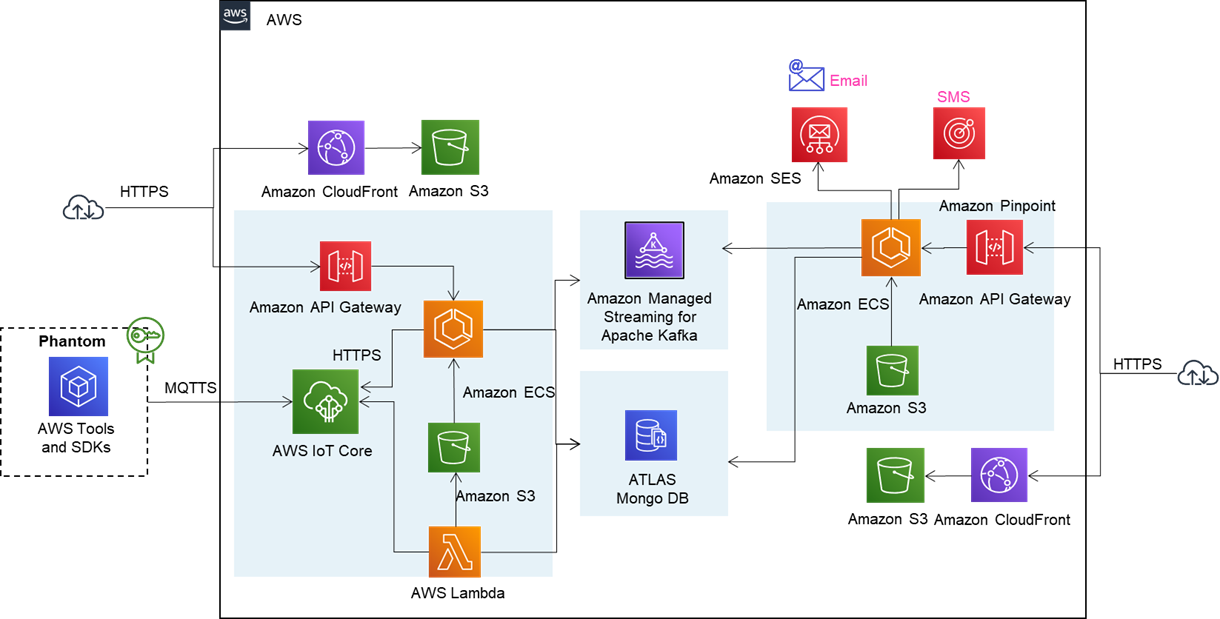AWS Partner Network (APN) Blog
Optimizing Energy Footprint with Edge Analytics and Artificial Intelligence of Things with Bosch Phantom
By Manan Chandna, Product Owner, Phantom – Bosch
By Suresh Seshadri, Product Lead, Phantom – Bosch
By Suman Saurabh, Gary Ong, and Dr. Stefan Schneider – AWS
 |
| Bosch |
 |
Our lives today are filled with more devices than ever before—in factories, retail stores, restaurants, and even our homes. As these devices keep multiplying, they are also multiplying our energy costs.
Energy and asset monitoring is becoming an essential part of business. Organizational strategies include environmental, social, and governance (ESG) criteria in its framework to decrease energy consumption and, at the same time, boost efficiency.
ESG has growing importance as customers are becoming more aware of the environmental impact organizations are making and are moving away from those who exploit the same. In addition, increasing energy prices boost the importance of ESG initiatives from a practical standpoint.
However, in a complex setup like distributed commercial spaces, it gets difficult to extract this information at an asset level and in detail. Bosch Phantom helps to extract this information using a non-intrusive approach.
In this post, we will discuss how Bosch is solving this problem with the help of edge analytics, machine learning, and core Internet of Things (IoT) components provided by Amazon Web Services (AWS).
Bosch Global Software Technologies (BGSW) is an AWS Advanced Tier Services Partner and AWS Marketplace Seller that provides end-to-end digital solutions enabling the transformation of enterprises through sensors, software, and services.
Current Energy Monitoring Practices
The current methods of monitoring energy have a lot of limitations associated with them:
- Traditional energy meter
- Provides limited data to act on.
- Access to the energy meter is mostly restricted.
- Energy consumption visibility is only at the time of billing.
- Smart meter
- Appliance-level information is not possible.
- Does not provide alerts or notifications.
- Does not provide comparison analysis tools.
- Building automation system
- Difficult to integrate multiple components into the system.
- Does not fit into distributed space.
- Maintenance costs are usually high.
The above-mentioned level of monitoring is not enough to achieve many of the stated sustainability goals of most organizations. Moreover, while the current solutions are difficult to integrate, it’s increasingly complicated for them to handle multiple communication standards and the technical standards of sensors, controls, and monitoring solutions.
Bosch Phantom Overview
Bosch Phantom is built as an AIoT platform, which combines the power of artificial intelligence (AI) and IoT at scale.
The solution offers IoT-based energy monitoring with edge computation and analytics capabilities. This enables transparency in energy consumption by providing a real-time view of electrical energy consumption, operating usage, electrical parameters, and appliance-level information.
The only two inputs required by Phantom are current and voltage, while AIoT takes care of the rest. The complete deployment period for the solution is about 5-6 days. The solutions can be applied to retail spaces, residential spaces, and commercial spaces.
Benefits of Phantom
- Phantom runs patented AI algorithms on the edge to analyze, interpret, and measure asset performance in real time.
- Introduces digitalization for legacy and modern machines.
- Non-intrusive installations assist in quick enablement without disturbing existing electrical layouts and infrastructure.
- Provides high scalability as it can be scaled to multiple numbers of distribution points.
- High resolution, granular, and real-time data are available for analytical decision making and drawing actionable insights.
- Multiple real-time monitoring use cases in residential, retail, commercial, utility distribution, and electrical machines in discrete manufacturing areas.
Individually Identifying Assets
With the help of an effective patented AI algorithm, Phantom can “see” multiple assets on a single line and monitor their activity separately. This is done using the energy signatures of various assets.
Phantom monitors the energy signatures of these assets and, over time, understands and assigns each unique signature to a unique asset. For example, the energy signature of a chiller compressor involves an on/off cycle and requires time to get to a steady state over each cycle, whereas the energy signature of an air handling unit (AHU) does not involve cycles and is the same across all phases with almost constant power demand.
Key Features of Phantom
The unique features of Phantom make energy and asset monitoring easier:
- Dashboard: Bosch offers a dedicated dashboard for Phantom which includes a host of information consolidated in one place. The dashboard can help with the following:
- Provides an overview of the number of monitored spaces and appliances.
- Monitor actual vs. target vs. projected energy consumption at a space, city, or even country level for a day, week, or month.
- Compare energy intensity across spaces, cities, and countries.
- Real-time monitoring: Phantom allows the user to monitor real-time electrical parameters at an appliance, area, and space level.
- Alerts and notifications: Phantom is not just capable of monitoring and capturing real-time data, it’s also capable of analyzing this data to look out for outlier cases and anomalies. Such cases are identified in case of change in historic power consumption, power leakages, load imbalance, and more. Whenever Phantom senses things happening out of the ordinary, it can send the user an alert about the same, hence making it possible to take required preventive action in time.
- Reports and analysis: With the help of Phantom’s capabilities, the user can generate timely reports, which can then be used to extract actionable insights in order to increase efficiency. Phantom offers big data processing and storage capabilities for batch and stream analytics of facility-related electrical data. Also, tools are readily available for analysis of topics such as trends, correlation, and asset benchmarking.
Phantom + AWS Synergy
The Phantom Energy Monitoring (EM) software-as-a-service (SaaS) application follows the well-known multi-tier (three-tier) architecture. This pattern divides the infrastructure into three layers: the “presentation” tier on the client side, the “business logic” tier on the web server side, and finally the “data” tier on the database server.
AWS managed services are leveraged in Phantom on two major fronts: firstly, in running the SaaS application under any variation of network and user traffic, and in managing the DevOps of the entire application.
In EM, the business logic layer is built as a collection of modular microservices using AWS managed services. The Phantom edge sensor leverages AWS IoT services to securely connect with the cloud application over the internet.
This enables the edge devices to receive firmware updates through the over-the-air (OTA) or firmware-over-the-air (FOTA) services. These services offer industry-standard MQTT communication with strong end-to-end encryption.
On the cloud, the data points are processed by AWS Lambda, a serverless computing service that enables Phantom to focus on building the microservices that respond to events (in this case, the messages from the edge sensors) and not worry about managing the infrastructure required to run them.
Lambda automatically manages the underlying compute resources, making them cost-efficient and hassle-free. These data points are then taken forward by the Amazon Simple Queue Service (SQS), which further takes the data for aggregation services that are run by Amazon Elastic Container Service (Amazon ECS) before storing them in the MongoDB Atlas database
In Phantom, the RESTful APIs and WebSockets are handled by Amazon API Gateway, a fully managed service that makes it easy for developers to create, publish, maintain, monitor, and secure APIs at any scale.
For IoT-based businesses, these cloud applications function as a platform where the variations in load and traffic on the servers can be quite huge. Without a clear DevOps and scaling plan, it becomes a huge task to keep the servers up and handling the load while still developing and releasing new features.
Phantom uses an array of AWS services such as AWS CodeCommit, CI/CD pipelines, AWS Lambda, Amazon ECS, and Amazon Elastic Compute Cloud (Amazon EC2), which seamlessly offers easy versioning and smooth one-click deployment automation.
Further, AWS CloudFormation templates enable the recreation and provisioning of the entire application in a matter of minutes. All of these services are located in multiple AWS Availability Zones (AZs) for every region.
Phantom is always maintained in two or three AZs to ensure high uptime. In the event of a disaster or failure of one AZ, all of the Phantom services will be re-provisioned within minutes without affecting the user experience.
On top of these, Phantom leverages other AWS services like Amazon Cognito for user management, Elastic Load Balancing for managing the incoming loads across the AZs, and Amazon Route 53 for traffic management.
Figure 1 – Bosch Phantom architecture diagram with AWS components.
Conclusion
Energy optimization and smart technologies have become the order of the day for businesses and homes. While most businesses talk about embracing artificial intelligence, few are pioneering this change.
With AI/ML, it’s important to invest in the right solutions and partners. Learn more about how Bosch Phantom is leading the way in energy monitoring and asset management. You can also learn more about Bosch in AWS Marketplace.
Bosch – AWS Partner Spotlight
Bosch Global Software Technologies (BGSW) is an AWS Advanced Tier Services Partner that provides end-to-end digital solutions enabling the transformation of enterprises through sensors, software, and services.

